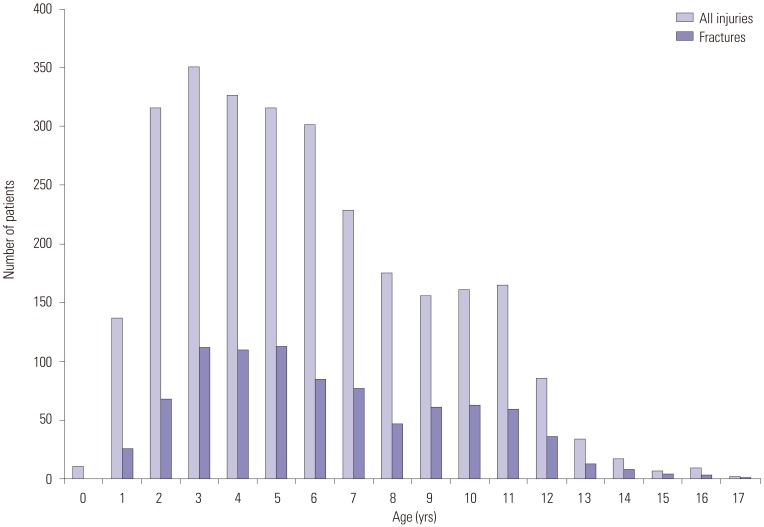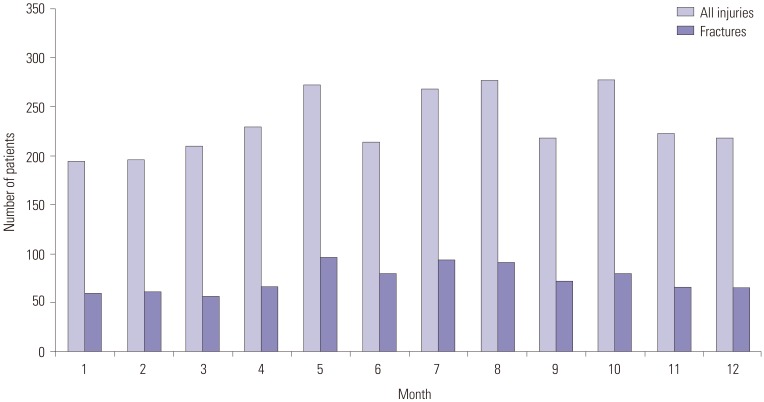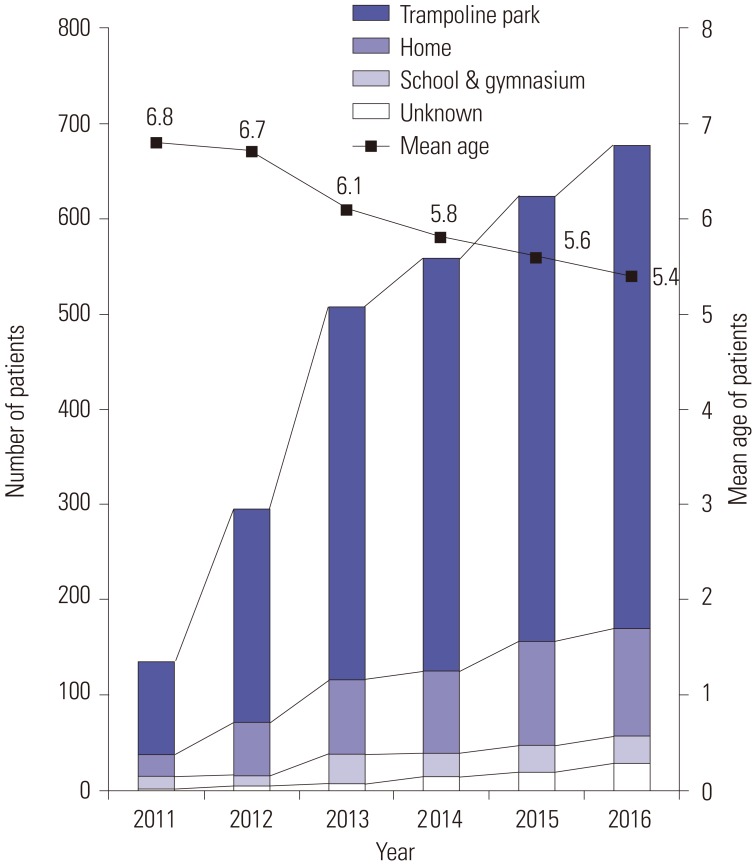Yonsei Med J.
2018 Oct;59(8):989-994. 10.3349/ymj.2018.59.8.989.
Pediatric Trampoline-Related Injuries in a Nationwide Registry in South Korea, 2011 to 2016
- Affiliations
-
- 1Department of Orthopedic Surgery, Chungnam National University School of Medicine, Daejeon, Korea.
- 2Department of Emergency and Critical Care Medicine, Gachon University Gil Medical Center, Gachon University College of Medicine, Incheon, Korea. emmetalkiller@gilhospital.com
- 3Department of Orthopedic Surgery, Gachon University Gil Medical Center, Gachon University College of Medicine, Incheon, Korea.
- KMID: 2419734
- DOI: http://doi.org/10.3349/ymj.2018.59.8.989
Abstract
- PURPOSE
Trampoline-related injuries are steadily increasing. To our knowledge, there have been very few studies on trampoline injuries in Asia. The purpose of this study is to report the characteristics of pediatric trampoline injuries in Korea.
MATERIALS AND METHODS
We conducted a nationwide retrospective cohort study. Data were collected from prospective nationwide databases (Emergency Department-based Injury In-depth Surveillance databases of the Korea Centers for Disease Control and Prevention) for patients who visited emergency departments (EDs) after injuries during 2011-2016.
RESULTS
Of 263712 patients between 0 and 17 years of age, 2799 patients with trampoline injuries visited EDs. The median age of the patients was 5 years (interquartile range, 3-8 years), and 63% of the patients were under 6 years old. Of the patients, 1526 (54.2%) were male. Seventy-six percent of injuries occurred at trampoline parks. Trampoline injuries and trampoline park injuries have increased steadily, while ages at injury have gradually decreased year by year (p < 0.001). Injury locations included the lower extremity (47%), head and face (24%), and upper extremity (24%). A fracture was sustained by 886 (31.7%) patients. The distal humerus and proximal tibia were the most common fracture sites (34% and 23%, respectively). Fractures occurred more commonly in trampoline parks than in homes (33.7% vs. 21.1%, p < 0.001).
CONCLUSION
In Korea, pediatric trampoline injuries and trampoline park injuries have tended to increase, while ages at injury have tended to decrease. Policies to prevent trampoline injuries are needed.
Keyword
MeSH Terms
Figure
Reference
-
1. Ashby K, Pointer S, Eager D, Day L. Australian trampoline injury patterns and trends. Aust N Z J Public Health. 2015; 39:491–494. PMID: 26123781.
Article2. Loder RT, Schultz W, Sabatino M. Fractures from trampolines: results from a national database, 2002 to 2011. J Pediatr Orthop. 2014; 34:683–690. PMID: 24686299.3. Brown PG, Lee M. Trampoline injuries of the cervical spine. Pediatr Neurosurg. 2000; 32:170–175. PMID: 10940766.
Article4. Leonard H, Joffe AR. Children presenting to a Canadian hospital with trampoline-related cervical spine injuries. Paediatr Child Health. 2009; 14:84–88. PMID: 19436467.
Article5. US Consumer Product Safety Commission. National Electronic Injury Surveillance System. Accessed on 2018 January 30. Available at: https://www.cpsc.gov/Research--Statistics/NEISS-Injury-Data.6. Wootton M, Harris D. Trampolining injuries presenting to a children's emergency department. Emerg Med J. 2009; 26:728–731. PMID: 19773494.
Article7. Council on Sports Medicine and Fitness, American Academy of Pediatrics. Briskin S, LaBotz M. Trampoline safety in childhood and adolescence. Pediatrics. 2012; 130:774–779. PMID: 23008455.8. Hume PA, Chalmers DJ, Wilson BD. Trampoline injury in New Zealand: emergency care. Br J Sports Med. 1996; 30:327–330. PMID: 9015596.
Article9. Mulligan CS, Adams S, Brown J. Paediatric injury from indoor trampoline centres. Inj Prev. 2017; 23:352–354. PMID: 27528404.
Article10. Shankar A, Williams K, Ryan M. Trampoline-related injury in children. Pediatr Emerg Care. 2006; 22:644–646. PMID: 16983249.
Article11. Kasmire KE, Rogers SC, Sturm JJ. Trampoline park and home trampoline injuries. Pediatrics. 2016; 138:e20161236. PMID: 27482060.
Article12. Hurson C, Browne K, Callender O, O'Donnell T, O'Neill A, Moore DP, et al. Pediatric trampoline injuries. J Pediatr Orthop. 2007; 27:729–732. PMID: 17878774.
Article13. Smith GA. Injuries to children in the United States related to trampolines, 1990–1995: a national epidemic. Pediatrics. 1998; 101(3 Pt 1):406–412. PMID: 9481005.14. Woodward GA, Furnival R, Schunk JE. Trampolines revisited: a review of 114 pediatric recreational trampoline injuries. Pediatrics. 1992; 89(5 Pt 1):849–854. PMID: 1579393.
Article15. Linakis JG, Mello MJ, Machan J, Amanullah S, Palmisciano LM. Emergency department visits for pediatric trampoline-related injuries: an update. Acad Emerg Med. 2007; 14:539–544. PMID: 17449791.
Article16. Klimek PM, Juen D, Stranzinger E, Wolf R, Slongo T. Trampoline related injuries in children: risk factors and radiographic findings. World J Pediatr. 2013; 9:169–174. PMID: 23677833.
Article17. Korea Consumer Agency. Survey of children safety. Accessed 2018 January 30. Available at: https://www.isafe.go.kr/children/select-BbsNttList.do?key=506&bbsNo=101&integrDeptCode=&pageUnit=10&searchCnd=SJ&searchKrwd=%ED%8A%B8%EB%9E%A8%ED%8E%84%EB%A6%B0.18. Korea Culture and Tourism Institute. Report of safety management system on amusement facilities . Accessed 2018 January 30. Available at: http://www.kcti.re.kr/03_1.dmw?method=view&reportId=100&isSearch=false&reportCategory=-1&reportTitle=false&userName=false&reportContent=false&reportSeq=1077&pageNum=1&groupNum=1.19. Committee on Injury and Poison Prevention and Committee on Sports Medicine and Fitness, American Academy of Pediatrics. Trampolines at home, school, and recreational centers. Pediatrics. 1999; 103(5 Pt 1):1053–1056. PMID: 10224191.20. The Minister of Health: Health Canada. Trampoline safety. Accessed 2018 January 30. Available at: https://www.canada.ca/en/health-canada/services/healthy-living/your-health/products/trampoline-safety.html?_ga=2.254006344.1791513137.1517293013-672512093.1517293013.21. Nysted M, Drogset JO. Trampoline injuries. Br J Sports Med. 2006; 40:984–987. PMID: 17000711.
- Full Text Links
- Actions
-
Cited
- CITED
-
- Close
- Share
- Similar articles
-
- Trampoline-related injuries in children: a nationwide cross-sectional study in South Korea
- Rapidly growing pediatric trampoline-related injuries in Korea: a 10-year single center retrospective study
- Trampoline-related injuries in Korea
- The Incidence of Pediatric Trampoline Injury: Statistics from a Single Institution
- Pediatric Injuries in Kids Cafés and Risk Factors for Significant Injuries: a 6-Year Cross-Sectional Study Using a Multicenter Injury Registry in Korea




